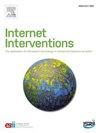基于互联网的抑郁症干预的治疗期望和抑郁症状二次分析
IF 4.1
2区 医学
Q1 HEALTH CARE SCIENCES & SERVICES
Internet Interventions-The Application of Information Technology in Mental and Behavioural Health
Pub Date : 2025-08-28
DOI:10.1016/j.invent.2025.100869
引用次数: 0
摘要
众所周知,治疗预期会影响治疗结果,但其在基于互联网的抑郁症干预(IBIs)中的作用尚不清楚。虽然以前的研究主要集中在期望作为治疗前预测因子(PTP),但新出现的证据表明,早期过程预测因子(EPPs),包括治疗过程中不断变化的期望,可能为治疗结果提供更相关的见解。目的:对一项析因试验(Bur et al., 2022)进行二次分析,探讨治疗预期在轻度至中度抑郁症基于互联网的干预中作为治疗前预测因子和早期过程预测因子的作用。它还探讨了期望与抑郁症状之间的时间关系,评估早期期望是否预测后来的症状严重程度,以及抑郁症状是否影响后来的期望。方法采用可信度和期望问卷(CEQ-8; Devilly &; Borkovec, 2000;德文版本:Walach et al. 2008)在基线(T0)、两周(T1)和四周(T2)测量治疗期望,同时在同一时间点和治疗后(T3)使用患者健康问卷-9 (PHQ-9; Kroenke et al., 2001)评估抑郁症状。为了分析治疗预期(CEQ-8)与治疗后抑郁症状(PHQ-9)之间的关系,在控制基线PHQ-9评分的情况下,采用简单回归模型。然后使用多元回归分析来检验CEQ-8是否预测PHQ-9,反之亦然。此外,作为敏感性分析,估计了一个交叉滞后面板模型(CLPM)来解释数据的重复测量结构。结果基线治疗预期对治疗后抑郁症状无显著预测作用。然而,在两周(T1)和四周(T2)测量的期望显著预测T3时的抑郁症状。多元回归分析结果表明,治疗预期可以预测抑郁症状的变化,而没有观察到相反的关系。CLPM得出的结果与回归分析一致,支持研究结果的稳健性。结论治疗预期在整个治疗过程中不断发展,似乎是症状改善的独立预测因子,而不仅仅是反映症状严重程度。在治疗早期监测和解决患者的期望可能会提高干预效果。这些发现支持将基于期望的策略纳入ibi以优化参与和有效性。本文章由计算机程序翻译,如有差异,请以英文原文为准。
Treatment expectations and depressive symptoms in an internet-based intervention for depression. A secondary analysis
Background
Treatment expectations are known to influence therapy outcomes, but their role in internet-based interventions (IBIs) for depression remains unclear. While previous research has primarily focused on expectations as a pre-treatment predictor (PTP), emerging evidence suggests that early process predictors (EPPs), including evolving expectations during treatment, may provide more relevant insights into therapeutic outcomes.
Objective
This secondary analysis of a factorial trial (Bur et al., 2022) investigates the role of treatment expectations as both a pre-treatment predictor and early process predictor in an internet-based intervention for mild to moderate depression. It also explores the temporal relationship between expectations and depressive symptoms, assessing whether earlier expectations predict later symptom severity and whether depressive symptoms influence subsequent expectations.
Methods
Treatment expectancy was measured using the Credibility and Expectancy Questionnaire (CEQ-8; Devilly & Borkovec, 2000; German version: Walach et al. 2008) at baseline (T0), two weeks (T1), and four weeks (T2), while depressive symptoms were assessed using the Patient Health Questionnaire-9 (PHQ-9; Kroenke et al., 2001) at the same time points as well as post-treatment (T3). To analyze the relationship between treatment expectations (CEQ-8) and depressive symptoms (PHQ-9 post-treatment), simple regression models were conducted while controlling for baseline PHQ-9 scores. Multiple regression analyses were then used to examine whether CEQ-8 predicted PHQ-9 or vice versa. In addition, as a sensitivity analysis, a cross-lagged panel model (CLPM) was estimated to account for the repeated-measures structure of the data.
Results
Baseline treatment expectations did not significantly predict depressive symptoms at post-treatment. However, expectations measured at two weeks (T1) and four weeks (T2) significantly predicted depressive symptoms at T3. The results of the multiple regression analyses indicate that treatment expectations can predict changes in depressive symptoms, whereas the reverse relationship was not observed. The CLPM yielded results that were consistent with the regression analyses, supporting the robustness of the findings.
Conclusions
Treatment expectations evolve throughout therapy and appear to function as an independent predictor of symptom improvement rather than merely reflecting symptom severity. Monitoring and addressing patient expectations early in treatment may enhance intervention outcomes. These findings support the inclusion of expectation-based strategies in IBIs to optimize engagement and effectiveness.
求助全文
通过发布文献求助,成功后即可免费获取论文全文。
去求助
来源期刊

Internet Interventions-The Application of Information Technology in Mental and Behavioural Health
Medicine-Health Informatics
CiteScore
6.50
自引率
9.30%
发文量
94
审稿时长
6 weeks
期刊介绍:
Official Journal of the European Society for Research on Internet Interventions (ESRII) and the International Society for Research on Internet Interventions (ISRII).
The aim of Internet Interventions is to publish scientific, peer-reviewed, high-impact research on Internet interventions and related areas.
Internet Interventions welcomes papers on the following subjects:
• Intervention studies targeting the promotion of mental health and featuring the Internet and/or technologies using the Internet as an underlying technology, e.g. computers, smartphone devices, tablets, sensors
• Implementation and dissemination of Internet interventions
• Integration of Internet interventions into existing systems of care
• Descriptions of development and deployment infrastructures
• Internet intervention methodology and theory papers
• Internet-based epidemiology
• Descriptions of new Internet-based technologies and experiments with clinical applications
• Economics of internet interventions (cost-effectiveness)
• Health care policy and Internet interventions
• The role of culture in Internet intervention
• Internet psychometrics
• Ethical issues pertaining to Internet interventions and measurements
• Human-computer interaction and usability research with clinical implications
• Systematic reviews and meta-analysis on Internet interventions
 求助内容:
求助内容: 应助结果提醒方式:
应助结果提醒方式:


